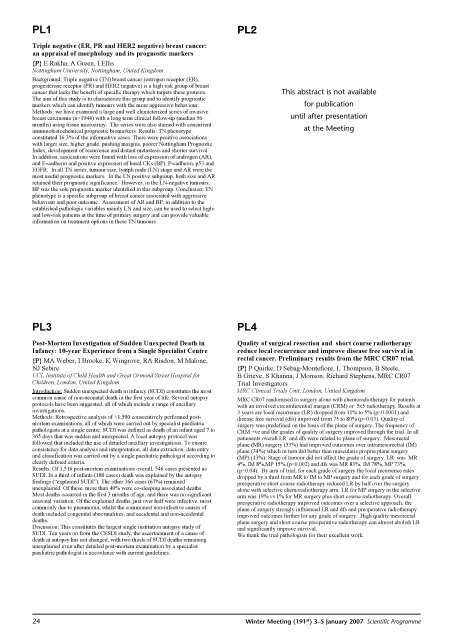2007 Winter Meeting - London - The Pathological Society of Great ...
2007 Winter Meeting - London - The Pathological Society of Great ...
2007 Winter Meeting - London - The Pathological Society of Great ...
- No tags were found...
You also want an ePaper? Increase the reach of your titles
YUMPU automatically turns print PDFs into web optimized ePapers that Google loves.
PL1PL2Triple negative (ER, PR and HER2 negative) breast cancer:an appraisal <strong>of</strong> morphology and its prognostic markers{P} E Rakha, A Green, I EllisNottingham University, Nottingham, United KingdomBackground: Triple negative (TN) breast cancer (estrogen receptor (ER),progesterone receptor (PR) and HER2 negative) is a high risk group <strong>of</strong> breastcancer that lacks the benefit <strong>of</strong> specific therapy which targets these proteins.<strong>The</strong> aim <strong>of</strong> this study is to characterize this group and to identify prognosticmarkers which can identify tumours with the more aggressive behaviour.Methods: we have examined a large and well characterized series <strong>of</strong> invasivebreast carcinoma (n=1944) with a long term clinical follow-up (median 56months) using tissue microarray. <strong>The</strong> series were also stained with concurrentimmunohistochemical prognostic biomarkers. Results: TN phenotypeconstituted 16.3% <strong>of</strong> the informative cases. <strong>The</strong>re were positive associationswith larger size, higher grade, pushing margins, poorer Nottingham PrognosticIndex, development <strong>of</strong> recurrence and distant metastasis and shorter survival.In addition, associations were found with loss <strong>of</strong> expression <strong>of</strong> androgen (AR),and E-cadherin and positive expression <strong>of</strong> basal CKs (BP), P-cadherin, p53 andEGFR. In all TN series, tumour size, lymph node (LN) stage and AR were themost useful prognostic markers. In the LN positive subgroup, both size and ARretained their prognostic significance. However, in the LN-negative tumours,BP was the sole prognostic marker identified in this subgroup. Conclusion: TNphenotype is a specific subgroup <strong>of</strong> breast cancer associated with aggressivebehaviour and poor outcome. Assessment <strong>of</strong> AR and BP, in addition to theestablished pathologic variables mainly LN and size, can be used to select highandlow-risk patients at the time <strong>of</strong> primary surgery and can provide valuableinformation on treatment options in these TN tumoursThis abstract is not availablefor publicationuntil after presentationat the <strong>Meeting</strong>PL3Post-Mortem Investigation <strong>of</strong> Sudden Unexpected Death inInfancy: 10-year Experience from a Single Specialist Centre{P} MA Weber, I Brooke, K Wingrove, RA Risdon, M Malone,NJ SebireUCL Institute <strong>of</strong> Child Health and <strong>Great</strong> Ormond Street Hospital forChildren, <strong>London</strong>, United KingdomIntroduction: Sudden unexpected death in infancy (SUDI) constitutes the mostcommon cause <strong>of</strong> non-neonatal death in the first year <strong>of</strong> life. Several autopsyprotocols have been suggested, all <strong>of</strong> which include a range <strong>of</strong> ancillaryinvestigations.Methods: Retrospective analysis <strong>of</strong> >1,500 consecutively performed postmortemexaminations, all <strong>of</strong> which were carried out by specialist paediatricpathologists at a single centre. SUDI was defined as death <strong>of</strong> an infant aged 7 to365 days that was sudden and unexpected. A local autopsy protocol wasfollowed that included the use <strong>of</strong> detailed ancillary investigations. To ensureconsistency for data analysis and interpretation, all data extraction, data entryand classification was carried out by a single paediatric pathologist according toclearly defined criteria.Results: Of 1,516 post-mortem examinations overall, 546 cases presented asSUDI. In a third <strong>of</strong> infants (180 cases) death was explained by the autopsyfindings (“explained SUDI”). <strong>The</strong> other 366 cases (67%) remainedunexplained. Of these, more than 40% were co-sleeping associated deaths.Most deaths occurred in the first 3 months <strong>of</strong> age, and there was no significantseasonal variation. Of the explained deaths, just over half were infective, mostcommonly due to pneumonia, whilst the commonest non-infective causes <strong>of</strong>death included congenital abnormalities, and accidental and non-accidentaldeaths.Discussion: This constitutes the largest single institution autopsy study <strong>of</strong>SUDI. Ten years on from the CESDI study, the ascertainment <strong>of</strong> a cause <strong>of</strong>death at autopsy has not changed, with two thirds <strong>of</strong> SUDI deaths remainingunexplained even after detailed post-mortem examination by a specialistpaediatric pathologist in accordance with current guidelines.PL4Quality <strong>of</strong> surgical resection and short course radiotherapyreduce local recurrence and improve disease free survival inrectal cancer. Preliminary results from the MRC CR07 trial.{P} P Quirke, D Sebag-Montefiore, L Thompson, B Steele,B Grieve, S Khanna, J Monson, Richard Stephens, MRC CR07Trial InvestigatorsMRC Clinical Trials Unit, <strong>London</strong>, United KingdomMRC CR07 randomised to surgery alone with chemoradiotherapy for patientswith an involved circumferential margin (CRM) or 5x5 radiotherapy. Results at3 years are local recurrence (LR) dropped from 11% to 5% (p













